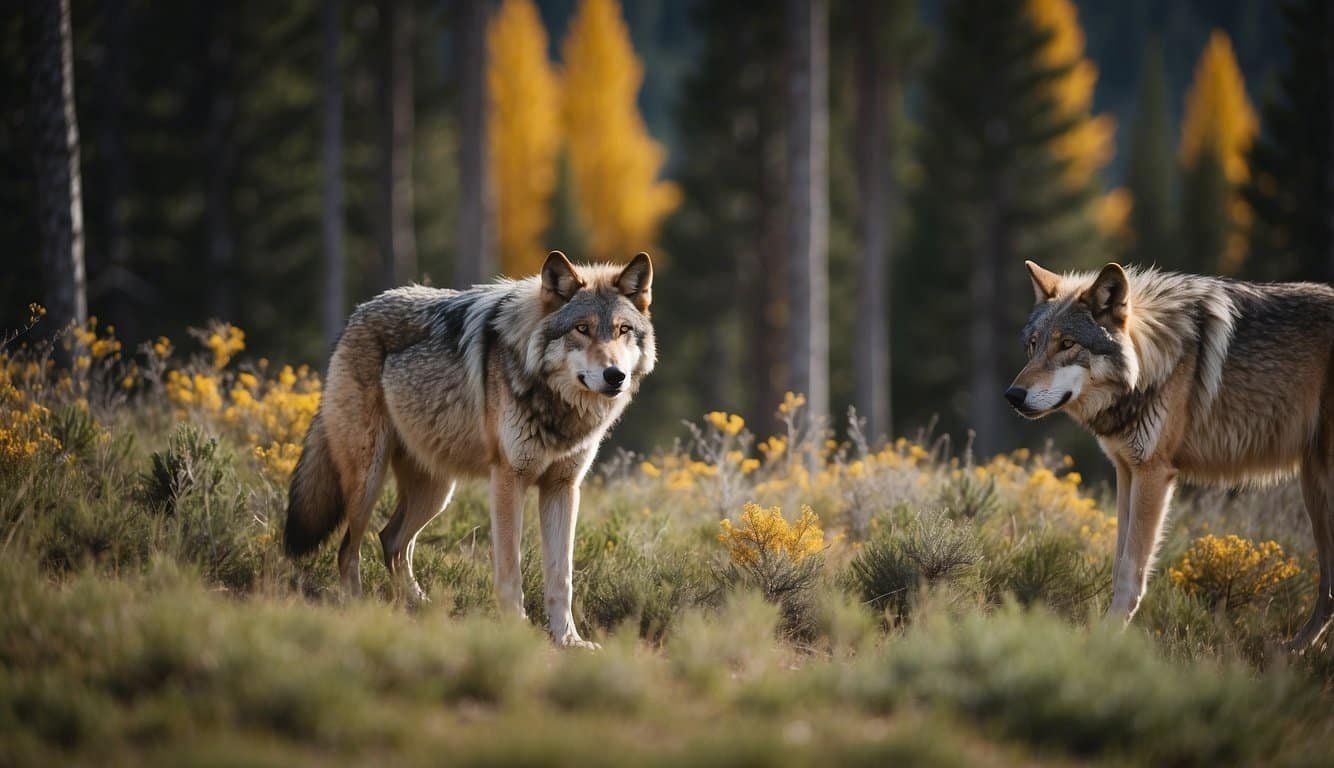Reintroduction of Wolves
The wolves’ return to Yellowstone National Park in the mid-90s marked a significant moment for ecological restoration. Wildlife biologists saw this as a pivotal step in restoring not just a top predator but also ecological balance.
Impact on Elk Populations
After the reintroduction of gray wolves, the overgrazing by abundant elk herds was addressed. Increases in predation by wolves led to a more balanced elk population, easing the pressure on certain plant species. Research indicates that wolves changed the browsing habits of elk, contributing to this effect.
Influence on Other Wildlife
The presence of wolves impacted not only elk but also other predators and scavengers. Bears, coyotes, and foxes benefit from wolves’ kills, while species like cougars and coyotes have faced increased competition. Notably, wolves have indirectly affected the behavior and population of smaller mammals and birds, adding to a more dynamic ecosystem.
Vegetation and River Health
Wolves’ predation on elk has allowed willow and aspen to flourish, providing a healthier habitat for a variety of species such as beavers. Beaver dams, in turn, have improved the health of streams and wetlands, with research outlining that wolves have played a key role in promoting aspen growth. These changes highlight the wolves’ integral part in enhancing the park’s vegetation and water systems.
Ecological Effects and Biodiversity

Wolves have played a pivotal role in the rebalancing of Yellowstone’s ecosystem. Their return to America’s first national park has set off a chain reaction known as a trophic cascade, where the presence of top predators like wolves can have profound effects on the environment, impacting numerous species and the physical landscape.
-
Wolves & Ungulate Populations: Predation by wolves has helped control the populations of large herbivores such as elk. This restored balance has allowed overgrazed plant species, including willow trees, to recover along the banks of rivers in Montana’s section of Yellowstone, thus enhancing habitat for beavers.
-
Beaver Activity & Waterways: The resurgence of beaver populations has had significant impacts on water habitats. Beaver dams create wetlands, which are beneficial for various wildlife forms and contribute to the biodiversity within the park.
-
Birds and Other Carnivores: With the wolves managing elk numbers, scientists have noted increased nesting sites for birds. Furthermore, wolves often leave behind carcass remains that provide food for scavengers like eagles and bears, strengthening the overall food web.
-
Plant Regrowth: Reduced grazing has allowed tree and shrubbery regrowth, which impacts the snowpack and climate. This regrowth has made rivers healthier and more stable, reducing erosion and improving the water quality.
Wildlife biologists like Doug Smith and wildlife ecologists have studied these patterns, confirming that the reintroduction of wolves to the Yellowstone wilderness has had an outsized positive effect on the park’s vitality and biodiversity. Their work underscores the intricacies of nature’s interconnection and underscores the importance of predators in maintaining healthy ecosystems in the face of ongoing challenges like climate change.
Conservation and Human Perspectives

The reintroduction of gray wolves into Yellowstone National Park is often hailed as a groundbreaking conservation project. Initially, the management of wolf populations was a point of intense debate. Ranchers worried about livestock safety, while environmentalists highlighted the critical role wolves played in maintaining ecological diversity.
Wolves, once eradicated from the park, were reintroduced in 1995. This bold move had transformative effects on the park’s ecosystem. One exciting outcome was the reduction in deer populations, which allowed vegetation, like aspens, to flourish. As a result, bird diversity took wing—songbirds returned in greater numbers, attracted by the thriving plant life.
Human perspectives on wolves have gradually shifted. Conservation efforts underscore the wolf’s role in supporting healthy ecosystems. In areas like Jasper National Park in Mexico, similar projects have underscored the positive impact of predators on declining species and overall biodiversity.
Wolves’ contributions extend beyond environmental benefits. They’re stars of countless documentaries and films, capturing human imagination. Through these stories, viewers witness the transformation of landscapes where wolves have played their part. The journey from eradication and conflict to coexistence and appreciation marks a significant chapter in Yellowstone’s history.
Successful wolf management involves innovative strategies to balance concerns of ranchers and conservationists. Livestock protection remains a priority, but it’s clear that wolves are an essential part of North America’s wildlife. They’re not just a symbol of wildness but a functional aspect of America’s natural heritage.
Discover more about the wolf’s impact on Yellowstone, or explore the human dimensions of wolf restoration in conservation.

